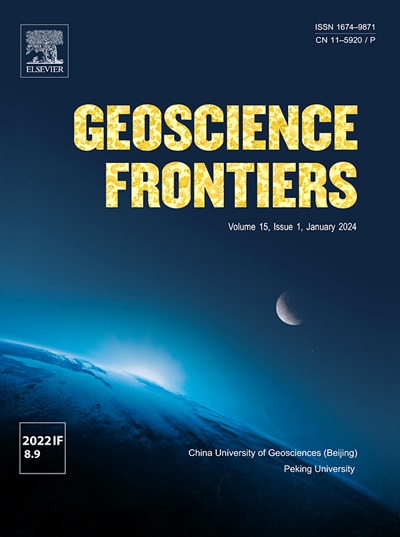晚石炭世—早二叠世野火特征、分布及其控制因素
IF 8.9
1区 地球科学
Q1 GEOSCIENCES, MULTIDISCIPLINARY
引用次数: 0
摘要
晚石炭世至早二叠世以广泛的成煤和频繁的古野火而闻名。尽管如此,随着时间的推移,这些野火的性质和分布变化很大。为了阐明晚古生代冰期古野火的模式,探讨冰窖条件下古野火的控制机制,对河北大城煤田太原组和山西组的煤样进行了综合分析。该数据集添加了晚石炭世至早二叠纪的全球惯性数据,并与上新世至全新世的古野火模式进行了比较。结果表明:华北大城煤田古山火由中规模、低强度的地面火灾向规模较大、强度较高的地面火灾过渡;在全球范围内,古野火的分布从300 Ma到290 Ma从欧洲转移到冈瓦纳、华夏和安加拉,并伴随着相应的惯性含量增加。这种野火活动的时空变化似乎受到古气候和大气条件的强烈影响。在300毫安时,较冷和较湿的古气候,加上相对较低的大气pO2水平,可能有助于减少古野火的发生率。相比之下,在290 Ma,冈瓦纳、华夏和安加拉的古气候变暖、大气pO2水平升高以及沼泽繁茂有利于古野火的发生。与较近的冰窖时期的比较进一步支持了这一模式。与晚石炭世-早二叠纪相似,从上新世到全新世野火活动增加,突出了气候条件在冰窖条件下推动野火扩散的关键作用。然而,更新世至全新世的野火强度低于晚石炭世至早二叠纪的野火强度,这表明大气氧浓度在调节火灾系统在地质时间尺度上的演变中发挥了关键作用。这些发现强调了气候、大气成分和植被在塑造地球历史上野火动态方面的复杂相互作用。本文章由计算机程序翻译,如有差异,请以英文原文为准。

Characteristics and distribution of late Carboniferous to early Permian wildfires and their controlling factors
The late Carboniferous to early Permian period is renowned for extensive coal formation and frequent paleowildfires. Nonetheless, the nature and distribution of these wildfires varied significantly over time. In an effort to elucidate the patterns of paleowildfires during the late Paleozoic Ice Age and to probe into the controlling mechanisms of paleowildfires under icehouse conditions, a comprehensive analysis was performed on coal samples from the Taiyuan and Shanxi formations within the Dacheng coalfield of Hebei Province, North China. The dataset was augmented with global inertinite data from the late Carboniferous to early Permian periods and was compared to paleowildfire patterns from the Pliocene to Holocene epochs. The results show that paleowildfires in the Dacheng coalfield of North China transitioned from moderate-scale, low-intensity surface fires to large-scale, relatively high-intensity ground fires. Globally, the distribution of paleowildfires shifted from Euramerica to Gondwana, Cathaysia, and Angara from 300 Ma to 290 Ma, accompanied by a corresponding increase in inertinite content. This spatial and temporal variation in wildfire activity appears to have been strongly influenced by paleoclimate and atmospheric conditions. At 300 Ma, cooler and wetter paleoclimate, coupled with relatively low atmospheric pO2 levels, likely contributed to a reduced incidence of paleowildfires. In contrast, at 290 Ma, warmer paleoclimate, higher atmospheric pO2 levels, and the flourishing mires in Gondwana, Cathaysia, and Angara were conducive to more intense paleowildfires. This pattern is further supported by the comparison to more recent icehouse periods. Similar to the late Carboniferous–early Permian period, wildfire activity increased from the Pliocene to the Holocene, highlighting the critical role of climatic conditions in driving wildfire proliferation under icehouse conditions. However, the Pleistocene to Holocene wildfires were less intense than those of the late Carboniferous–early Permian, suggesting that atmospheric oxygen concentrations played a key role in modulating the evolution of the fire systems over geological timescales. These findings underscore the complex interplay between climate, atmospheric composition, and vegetation in shaping wildfire dynamics across Earth’s history.
求助全文
通过发布文献求助,成功后即可免费获取论文全文。
去求助
来源期刊

Geoscience frontiers
Earth and Planetary Sciences-General Earth and Planetary Sciences
CiteScore
17.80
自引率
3.40%
发文量
147
审稿时长
35 days
期刊介绍:
Geoscience Frontiers (GSF) is the Journal of China University of Geosciences (Beijing) and Peking University. It publishes peer-reviewed research articles and reviews in interdisciplinary fields of Earth and Planetary Sciences. GSF covers various research areas including petrology and geochemistry, lithospheric architecture and mantle dynamics, global tectonics, economic geology and fuel exploration, geophysics, stratigraphy and paleontology, environmental and engineering geology, astrogeology, and the nexus of resources-energy-emissions-climate under Sustainable Development Goals. The journal aims to bridge innovative, provocative, and challenging concepts and models in these fields, providing insights on correlations and evolution.
 求助内容:
求助内容: 应助结果提醒方式:
应助结果提醒方式:


